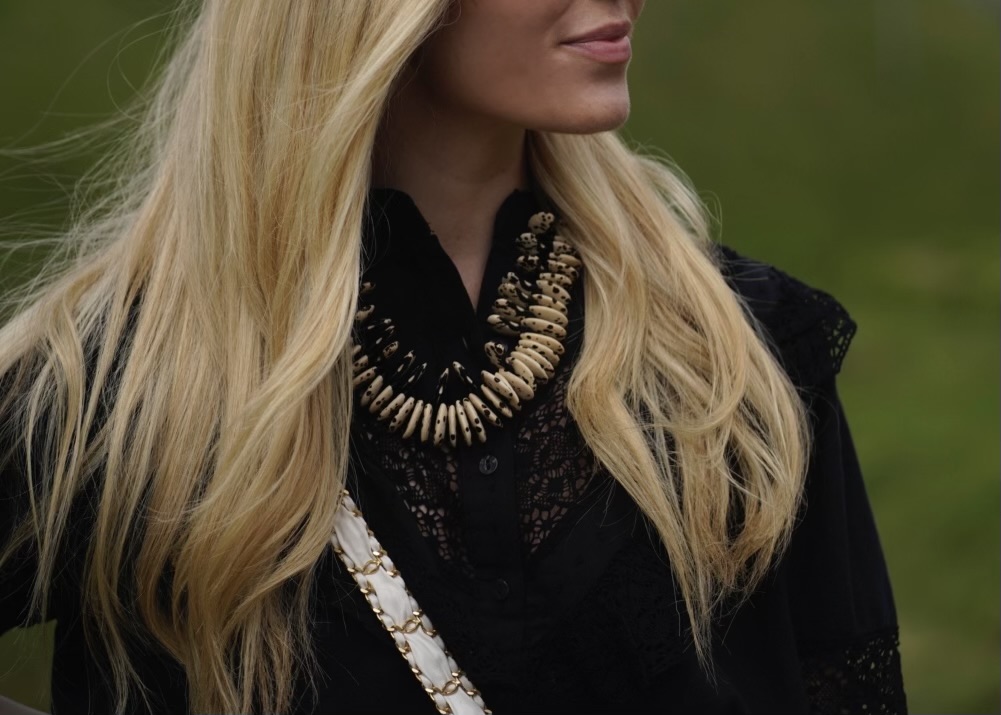The Future of Fashion is Spiritual

It’s easy to look at a bean, or a leaf, and consider how that thing is connected to nature — to see its relationship to the soil or a tree.
Why should our fashion be any different?
This question crossed my mind recently when purchasing a necklace from the Colombian artist Xandra Uribe. It’s the most beautiful piece of jewelry that I own, but it isn’t made of gold or precious stones — it's made of beans. Uribe’s work is deeply inspired by indigenous traditions and materials, which makes the necklace feel like more than just an accessory. For me, it’s a reminder that I’m constantly connected to the earth. It whispers to me that the boundaries between myself and nature are not as rigid as they might seem.
The Arhuaco people in Colombia's Sierra Nevada de Santa Marta mountains consider beans as sacred, living beings. Like many other indigenous cultures, the natural world and its materials are revered and respected. To wear a necklace made from beans is to carry these beliefs close to the heart. Nature is not a resource to be exploited, but a form of life that we must live in harmonious relationship with.
In our modern world, fashion often feels distant from nature. We wear clothes that are produced on a massive scale, made of synthetic materials that take hundreds of years to decompose, and pass through supply chains that stretch across the globe. This system is designed for speed, efficiency, and profit, but it rarely considers the relationship between the materials and the earth from which they come.
Our environmental crisis is not just a material issue, but also a spiritual one. Ecological degradation results from the growing disconnection between humans and the natural world. Spiritual ecology offer us a perspective which can change our perception and creation of fashion. It acknowledges that all life is sacred and interconnected, and suggests that we should act in ways that honor this connection.
Whether it’s a bean necklace, a pair of wool socks, or a synthetic jacket — all garments have stories that begin in nature. Approaching fashion through the lens of spiritual ecology invites us to rediscover these stories, to see our clothes as part of a living, breathing system, and to engage with fashion in a way that respects both the earth and the people who create what we wear. From this perspective, a garment is more than just a piece of fabric; it’s a reminder of the soil the produced it, the labor that harvested it, and the ecosystem that nurtured it. We are invited to slow down, to think beyond trends and seasons, and to cultivate a deeper awareness of the lifecycle of our clothing.
Of course, it’s not always easy to integrate these principles into all aspects of our wardrobe. The realities of modern life often necessitate convenience and affordability, but that doesn’t mean we can’t seek out reconnection. Even small choices — like selecting handmade, natural pieces when possible, or taking special care of the clothing we already have — can remind us of spiritual ecology's interconnectedness. No matter what our relationship to fashion looks like right now, we can always start by practicing more gratitude.
There can be a certain vulnerability in this approach. When I wear the bean necklace, I’m aware that it won’t last forever. It might crack or sprout if I get caught in the rain and, eventually, will return to the earth. It’s a far cry from the permanence that we often seek in our possessions. Yet, there’s something liberating about embracing this impermanence, about acknowledging that everything in nature — including us — is part of a cycle of growth, decay, and renewal. It’s a reminder that fashion, like life, is meant to be lived in relation to the natural world.
In the end, the bean necklace is more than a piece of jewelry; it’s a teacher, a ritual, and a reminder. It shows me that fashion can be more than surface-level beauty. It can be a way to tell stories, to practice mindfulness, and to reconnect with the earth. When I put it on, I think about the hands that threaded each bean, the land from which they came, and the ancient wisdom that sees value in the small and humble. It’s a perspective that encourages me to see my wardrobe not just as a collection of things but as a reflection of my relationship with the world.
And in a time when the planet is calling out for us to remember our place within it, perhaps that’s one of the most beautiful things we can wear.





